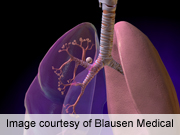
MONDAY, Sept. 15, 2014 (HealthDay News) — Adding chest radiation to chemotherapy allows some people with small-cell lung cancer to live longer and cuts recurrence rates by nearly 50 percent, European researchers report.
Based on the results of a four-country study, the researchers recommended that chest radiotherapy be routinely offered to patients with advanced small-cell lung cancer who respond to chemotherapy.
Small-cell lung cancer (SCLC) is an aggressive form of the disease that accounts for roughly 13 percent of all lung cancers. For most people, the disease spreads to other parts of their body. But chest (thoracic) radiation is not regularly given to patients with small-cell lung cancer, the researchers pointed out.
“Although most SCLC patients have persistent tumors within the chest after chemotherapy, at present local thoracic radiotherapy is not generally given because of the spread of disease outside the thorax, and is reserved for [ease] of symptoms,” study author Dr. Ben Slotman, a radiation oncology professor at VU University Medical Center in Amsterdam, said in a news release from The Lancet.
The research was published Sept. 14 in the journal, to coincide with its presentation at the American Society for Radiation Oncology’s annual meeting in San Francisco.
“In recent years, we have made some progress in improving survival by giving prophylactic cranial radiotherapy [radiation to the head to reduce the risk of cancer spreading to the brain] after chemotherapy, and this is now considered the standard of care. However, survival for patients with extensive disease remains poor [two-year survival of less than 5 percent] and the likelihood of the cancer recurring and spreading to other parts of the body remains high,” Slotman noted.
The study involved 498 adults undergoing chemotherapy at 42 facilities in the Netherlands, the United Kingdom, Norway and Belgium. The patients were randomly assigned to two weeks of standard care with either radiation to the head alone or radiation to the head and chest.
Although survival rates among the two groups of patients was similar during the first year, by the second year, 13 percent of patients who received head and chest radiation had survived, compared to 3 percent of those who received standard therapy.
Six months after treatment, 7 percent of patients who underwent chest radiation did not experience a worsening of their condition, compared to 24 percent of those who received standard therapy.
The researchers noted that 20 percent of patients who received chest radiation had a recurrence of cancer in their thorax, compared to 46 percent of those who only received head radiation.
Slotman noted, “While local control of the disease was good, the majority of patients still had disease progression outside the thorax and brain, indicating that additional radiotherapy should be investigated at sites of extrathoracic disease as well.”
One expert lauded the findings.
The study “is provocative, and possibly practice-changing, in the treatment of extensive stage small-cell lung cancer,” said Dr. Jed Pollack, chair of radiation medicine at Lenox Hill Hospital in New York City. “These results represent an incremental, but important, step forward in the treatment of extensive stage small-cell lung cancer. It would be intriguing to see whether or not a dose-escalation study could show even further survival benefit.”
Dr. Jan P. van Meerbeeck, from Ghent and Antwerp University in Belgium, and Dr. David Ball, from the University of Melbourne in Australia, wrote a commentary that accompanied the study.
“Refreshingly, the radiotherapy in Slotman and colleagues’ study was not technically complex, and it would be easy to provide at low cost in even the most modestly resourced radiotherapy departments,” they said in the journal news release.
More information
The American Lung Association has more on treatment for lung cancer.
Copyright © 2025 HealthDay. All rights reserved.

